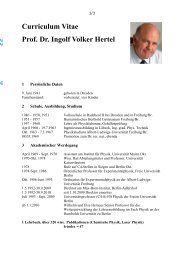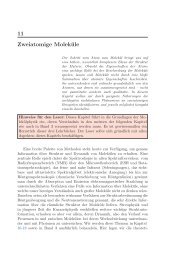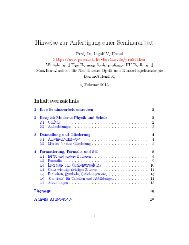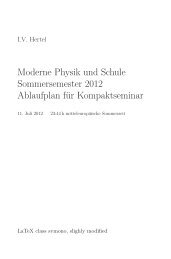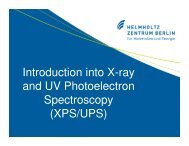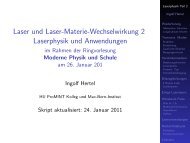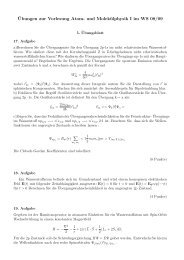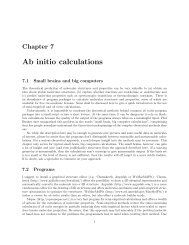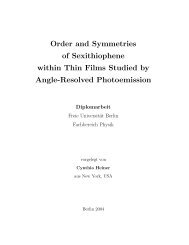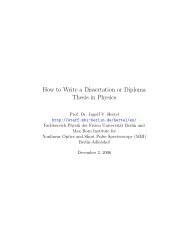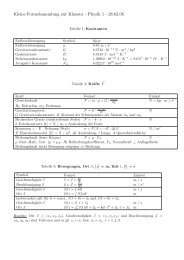Lecture
Lecture
Lecture
You also want an ePaper? Increase the reach of your titles
YUMPU automatically turns print PDFs into web optimized ePapers that Google loves.
The Dynamical World ofCarbon NanostructuresEleanor CampbellSchool of Chemistry,Edinburgh Universityeleanor.campbell@ed.ac.uk
Molecules/ClustersAtoms/A&OLaser AblationC 60Others(Surfaces, lasers, CNT...)Year ?
EEBC, HS, IVH1985/1986UV laserpulsepolyimide
Curl, Kroto and Smalley’s discovery, 1985Nobel Prize in Chemistry1996C 60 C 70Suggestion of hollow cage structure toexplain magic numbers in massspectra: the fullerenes
Serendipity on a materials science detourUV laser ablation of polyimidewas a very topical subject inthe mid-eighties.UV laserpulse1989polyimideWe had to do ”something relevant”and decided to look at the massesof the ablation products
Nature 347 (1990) 3541800Solar cells16001400Number of Papers1200100080060040020001985 1990 1995 2000 2005Year
FullerenesModel systems for learning aboutthe dynamical behaviour of complexmolecules+ns laserCollisionshigh vib.excitationBlack bodyradiation+ e delayed ionisationmetastable fragmentation
DDynamics of Fullerene CollisionsC 120FusionFragmentationIntra-clustermolecular fusion
Capturing AtomsC 60+He Mass Spectrometer Det.Capture Cross Section / A22117 eVR 12 ≈ 3 Å⎡ = 2 Vσ πR ⎢ −B12 1 He⎣ E CM2 mechanisms for capture6 eVR 12 < 1 Å00.00 0.05 0.10 0.15 0.20⎤⎥⎦1/E cm/eV -1 Endohedral Fullerene
1992 Adlershof
There were times when it didn’t seem such a good idea......Pictures taken 2 weeks before the planned lab move from Freiburg
But soon we were ready to celebrate theofficial opening of the Max Born Institute
How do highly excited fullerenes behave?fs-ps+ nhν ?When does statisticalbehaviour appear?MBIUltrashort Pulses (< 50 fs)Strong field - multipleionisationCoherent controlGothenburgLonger pulses, lowerintensitiesStatistical modellingIonisation mechanism
PES & MS same fluence, different pulse durationElectronsca. 3.5 J/cm 2IonsIntensity / arb. units10 310 2hν25 fsATI10 310 210ca, 20000 K250 500 fs fsbaC 602+C 60+MPI(t < 50 fs)Energy / eVhot electronscold ”lattice”(50 fs < t < 500 fs)A5 ps10 2100 2 4 6 8ca. 5000 KdTime of Flightstatistical energydistribution, strongvibrational excitation(t > 500 fs)Electron Energy / eVCampbell et al., Phys. Rev. Lett. 84 (2000) 2128
Use VMI to study the energy and angular distribution of theemitted electrons10000180 fsSlope gives an effective electron temperatureIntensity [arb. units]1000100102 J/cm 2 3 J/cm 2 4 J/cm 21.5 J/cm 25 J/cm 210 5 10 15 20Electron Kinetic Energy [eV]Tunable
3 x 10 12 W/cm 2The thermal delayedionisation (thermionicemission) seen with nsexcitation ishomogeneous, asexpected(C. Bordas)130 fs, 800 nm, logarithmic1 x 10 13 W/cm 2
3 x 10 12 W/cm 2 Atomlike hollow130 fs, 800 nm, linearAtomlike hollowcore-bound MOof C 60Feng et al., Science,320 (2008) 359STS of singleC 60 onsubstrate
1 photon ionisation +laser heatingTClusters fragment by evaporatingfullerene monomersM.Hedén et al. Phys.Rev.A 71 (2005) 055201K.Hansen et al. JCP 105 (1996) 6088
Heden et al., EPJD 43 (2007) 255Intensity (arb. units)C nC 60C 7090 100 110 120 130 14080 100 120 140 160 180 200 220 240nPeak Area (arb. units)(C 60 ) 2(C 70 ) 2C 60C 70Fusion Threshold (eV) 85 ± 5 100 ± 10Low mass cut-offdetermined by competitionwith double ionisationLargest DetectedDimer FragmentExpected MaxFragment Ion RangeC 116+C 130+108-118 126-138C 106+ corresponds to initialinternal energy of ca. 125eV. For this energy, doubleionisation of (C 60 ) 2 occurswith a rate of ca. 6x10 13 s -1 .
Competition between fusion and multiple ionisationNormalised Intensity0.60.50.40.30.20.10.00.60.50.40.30.2a∆E Fusion = 10 eV96 100 104 108 112 116 120b∆E Fusion = 20 eVCalculated dimerfragment distributionsfrom different neutralprecursor clusters400300200100C 106+C +1160130 140 150 1600.10.096 100 104 108 112 116 120Number of Carbon Atoms, nHansen et al., Israeli J. Chem., 47 (2007) 43Narrower than observedexperimentally - realcluster IP’s not properlyaccounted for
CNTSize and mobility of excitons in (6, 5)carbon nanotubesNature Physics 5 (2009) 54T. Hertel
Growth StudiesTransistorsRelaySchottky BarriersLaserRaman/AFMStudiesForceCluster depositionL 02δLocal HeatingGrowthPhotonic Crystals
Advantages of Carbon Nanotubes for NEMSLow MassHigh Young’s modulus (E)High integration density??Continuum beam mechanics can be used to model behaviourPull-in voltage:Want low mass, low Eand long tube (L) tominimise pull-in voltageV PI∝EmLFrequency:Want high E andshort tube (L) forhigh frequency1f ∝2LEρ
Contact Mode Nanotube NanorelayKinaret et al, Appl. Phys. Lett. 82 (2003) 1287; Jonsson et al., J. Appl. Phys. (2004)
contact25noncontact20Current [µA]151050FirstSecondS.W. Lee et al,Nano Lett 4(2004) 20270 5 10 15 20 25V sg[V]V sd = 0.5 V
High Frequency PropertiesContactNon-contactThe resonance frequency can be tuned byseveral GHz by tuning the gate voltage.L.M. Jonsson, J. Kinaret et al., Nanotechnology 15, 1497 (2004).
Tunable RF Transmission of Two-Terminal Relay:Direct measurement of transmission signal2-terminal relay200 nmApply a DC bias between source and drain. CNT becomes chargedand a capacitive coupling is induced.If the CNT is at mechanical resonance, the electric field will varyharmonically, thus inducing an ac current at the drain that can bemeasuredModeling: J. Kinaret, A. Isacsson, CTHEriksson et al., Nano Lett 8 (2008) 1224
a) b)-52.5S21 [dB]-53.0-53.5-54.0-54.516V14V12V10V 8V-55.0-55.550 52 54 56 58 60 62Frequency [MHz]c) 62d)Resonant Frequency [MHz]6160595857565554530 50 100 150 200 250 300 350V 2 SD [V2 ]Q L555045403530252050 100 150 200 250 300 350V 2 SD [V2 ]Anders Eriksson et al., Nano Lett. 8 (2008) 1224
MEMS/NEMS from arrays of vertically alignedmultiwalled nanotubesNovoltageappliedVoltageappliedbetweentubes
Want thin, tall walls tominimise voltage neededto actuate the varactor
C parasiticZ inR1R2Z outC ground1C CNTC ground2CNT grown on200nm thickMo electrodesusing 1nmFe/Alumina,acetylenegrowth
Looking down on Varactor with Optical MicroscopeTop focusCatalyst separation: 20 µmThickness: 6 µmHeight: 70 µm
a)60Separation [µm]555045400 10 20 30 40 50Voltage [V]Effective Young’sModulus 4 MPa(cf 300 GPa - TPa)MEMS modelling T. Idda, LAAS
N. Olofsson et al., Nanotechnology 20 (2009) 385710
The TeamNanotubesS.W. Lee (now Konkuk Univ)A. Eriksson (now Ericsson)G.H. Jeong (now Kangwon Univ)O.A. Nerushev (EU)A.V. Gromov (EU)Theory CollaborationsCNT NEMSJ. Kinaret (CTH)A. Isacsson (CTH)Y. Tarakanov (CTH)Cluster DepositionK. Nordlund (HU)J. Samela (HU)N. Olofsson (GU)J. Svensson (GU)S. Dittmer (now Ringhals)R. Rehammar (GU/Chalmers)J. Ek-Weis (EU)C. Sapcharoenkun (EU)Fullerenes/fs laser int.K. Hansen (GU)M. Heden (now Semcon)M. Kjellberg (GU)O. Johansson (EU)G. Henderson (EU)Cluster DepositionV. Popok (GU)S. Vuckovic (GU)



